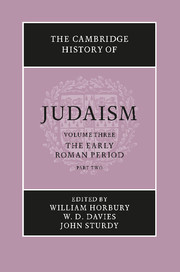Book contents
- Frontmatter
- 1 The archaeology of Palestine 63 bce–ce 70
- 2 The Herodian Temple
- 3 Recent archaeology in Palestine: achievements and future goals
- 4 The contribution of Jewish inscriptions to the study of Judaism
- 5 The social, economic and political history of Palestine 63 bce–ce 70
- 6 The Diaspora in the Roman period before ce 70
- 7 The Gentiles in Judaism 125 bce–ce 66
- 8 Gentiles as seen by Jews after ce 70
- 9 The synagogue
- 10 The Temple and the synagogue
- 11 The early liturgy of the synagogue
- 12 Women in the synagogue
- 13 The Pharisees
- 14 The Sadducees – their history and doctrines
- 15 The Essenes
- 16 The baptist sects
- 17 The troublemakers
- 18 The Samaritans and their sects
- 19 Galilean Judaism and Judaean Judaism
- 20 Jesus: from the Jewish point of view
- 21 Paul: from the Jewish point of view
- 22 Jewish Christianity
- 23 Apocalyptic: the disclosure of heavenly knowledge
- 24 The Qumran sectarian writings
- 25 The Dead Sea Scrolls and pre-Tannaitic Judaism
- 26 Prayer in the Qumran Texts
- 27 Philo of Alexandria
- 28 Josephus (ce 37–c. 100)
- 29 The rabbi in second-century Jewish society
- 30 The Hellenistic–Roman Diaspora ce 70–ce 235: the archaeological evidence
- 31 The legacy of Egypt in Judaism
- 32 Jewish elements in gnosticism and magic c.ce 70–c.ce 270
- Bibliographies
- Index
- References
15 - The Essenes
Published online by Cambridge University Press: 28 March 2008
- Frontmatter
- 1 The archaeology of Palestine 63 bce–ce 70
- 2 The Herodian Temple
- 3 Recent archaeology in Palestine: achievements and future goals
- 4 The contribution of Jewish inscriptions to the study of Judaism
- 5 The social, economic and political history of Palestine 63 bce–ce 70
- 6 The Diaspora in the Roman period before ce 70
- 7 The Gentiles in Judaism 125 bce–ce 66
- 8 Gentiles as seen by Jews after ce 70
- 9 The synagogue
- 10 The Temple and the synagogue
- 11 The early liturgy of the synagogue
- 12 Women in the synagogue
- 13 The Pharisees
- 14 The Sadducees – their history and doctrines
- 15 The Essenes
- 16 The baptist sects
- 17 The troublemakers
- 18 The Samaritans and their sects
- 19 Galilean Judaism and Judaean Judaism
- 20 Jesus: from the Jewish point of view
- 21 Paul: from the Jewish point of view
- 22 Jewish Christianity
- 23 Apocalyptic: the disclosure of heavenly knowledge
- 24 The Qumran sectarian writings
- 25 The Dead Sea Scrolls and pre-Tannaitic Judaism
- 26 Prayer in the Qumran Texts
- 27 Philo of Alexandria
- 28 Josephus (ce 37–c. 100)
- 29 The rabbi in second-century Jewish society
- 30 The Hellenistic–Roman Diaspora ce 70–ce 235: the archaeological evidence
- 31 The legacy of Egypt in Judaism
- 32 Jewish elements in gnosticism and magic c.ce 70–c.ce 270
- Bibliographies
- Index
- References
Summary
The Essenes formed a third religious group among the Jews of Palestine, after the Pharisees and Sadducees. They existed from the middle of the second century bce up to the time of the first Jewish uprising against the Romans. Until recently our knowledge of them was derived entirely from Philo, Josephus and Pliny the Elder, all of whom wrote as outsiders. Now, however, the Dead Sea Scrolls discovered from 1947 onwards (the Qumran manuscripts) have provided us with what might be regarded as authentic Essene documents – though the name itself never occurs in them (for discussion see chapters 24–5, below). Both sources complement each other: the classical authors are particularly important for factual information such as dates, places and the way of life of the Essenes, while the Qumran texts also reveal the theological foundations of their singular faith.
FACTUAL INFORMATION
SOURCES
The Alexandrian Jewish philosopher Philo (15/10 bce–ce 45) in his treatise ‘Every good man is free’ and in a subsequent ‘Apology for the Jews’ depicts the Essenes as an example of a truly free and righteous existence. These two accounts bear a close resemblance to one another linguistically and also in context, not least because the author saw his own Platonic and Stoic ideals realized in the life of the Essenes. Flavius Josephus (ce 37–100), who claimed to have belonged to all the different Jewish religious factions in his youth, including the Essenes, offers us a more detailed account of this latter sect than any other author, in his work on The Jewish War. He also mentions them frequently in brief remarks and anecdotes in his main work Antiquities of the Jews.
- Type
- Chapter
- Information
- The Cambridge History of Judaism , pp. 444 - 470Publisher: Cambridge University PressPrint publication year: 1999
References
- 2
- Cited by

